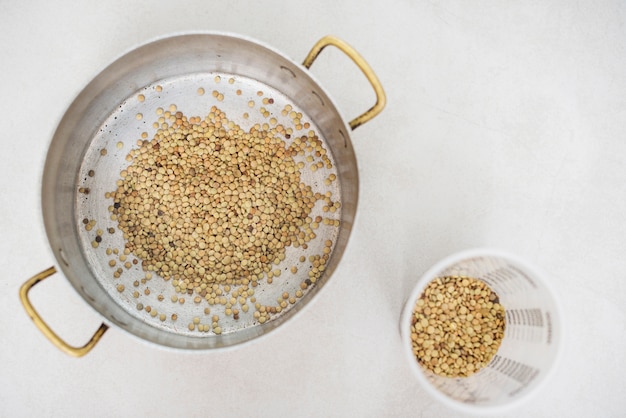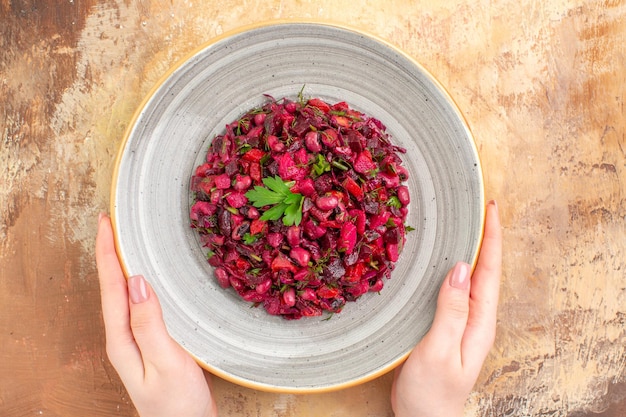(Part 1) What is Amaranth?

A Journey Back in Time: The History of Amaranth
Forget quinoa, amaranth was the "it" grain in ancient times! Pronounced "am-uh-ranth," this little grain has been around for thousands of years, originally cultivated in the Americas. It was a staple food for the Aztecs and Incas, considered so valuable that it even held religious significance. The name "amaranth" itself comes from the Greek word "amarantos," meaning "unfading." This refers to the grain's ability to stay fresh for a long time, making it a true symbol of resilience and longevity.Sadly, amaranth's popularity faded over time, but thanks to its remarkable nutritional value and culinary versatility, it's experiencing a well-deserved comeback in modern times.
Nourishing Power: The Nutritional Benefits of Amaranth
If you're looking for a nutritious addition to your diet, amaranth is a winner! It's a good source of protein, fiber, and essential minerals like iron, magnesium, and zinc. But that's not all! It's also packed with antioxidants, which help protect your cells from damage.The best part? Amaranth is naturally gluten-free, making it a fantastic option for people with gluten sensitivity or celiac disease.
It's worth noting that amaranth is an excellent source of lysine, an essential amino acid crucial for growth and development, particularly important for children.
Debunking the Myth: Amaranth vs. Quinoa
Now, you might be thinking, "Isn't amaranth just like quinoa?" While both are ancient grains, they have distinct characteristics. Amaranth has a slightly nutty flavour and a firmer texture than quinoa, offering a different culinary experience.Here's a quick comparison to help you decide which grain suits your taste and needs:
| Amaranth | Quinoa | |
|---|---|---|
| Texture | Firm, slightly chewy | Fluffy, slightly crunchy |
| Flavor | Nutty, slightly sweet | Mildly earthy |
| Nutritional Profile | Higher in protein and iron | Higher in fiber |
Both are great choices, and ultimately, it depends on what you're looking for in your meal.
(Part 2) Cooking with Amaranth

The Simple Art of Preparing Amaranth
Cooking amaranth is a breeze! You can treat it much like rice or quinoa, with a few simple steps to keep in mind:- Rinse the grains: Before cooking, give your amaranth a quick rinse under cold water. This helps remove excess starch and prevents the grains from clumping together, ensuring a fluffier final product.
- Get the ratio right: For every cup of amaranth, use two cups of water. This ensures even cooking and prevents the amaranth from becoming mushy.
- Simmer to perfection: Bring the water to a boil, then reduce the heat to low, cover the pot, and simmer for about 20 minutes.
- Fluff and cool: Once cooked, gently fluff the amaranth with a fork. Let it cool slightly before serving, allowing it to absorb the remaining moisture.
Mastering the Art: Tips for Cooking Amaranth
Here are a few tips to help you cook the perfect amaranth every time:- Don't overcook it!: Amaranth can turn mushy if you cook it for too long. Keep an eye on it and make sure it doesn't become too soft.
- Explore cooking methods: Beyond the classic stovetop method, you can steam amaranth, bake it in the oven, or even use it in a slow cooker for a hands-off approach.
- Add flavour with confidence: While amaranth has a lovely nutty flavour on its own, feel free to add spices, herbs, or even vegetables while it's cooking to create unique and delicious flavour combinations.
(Part 3) Amaranth Recipes

A Taste of the Morning: Breakfast Dishes
Amaranth is a fantastic addition to your breakfast routine, adding a nutritious kick to your morning meals. Here are a few ideas to get you started:- Amaranth porridge: It's like oatmeal, but with a slightly nutty flavour! Add your favourite toppings like fresh fruit, toasted nuts, and seeds for a hearty and healthy breakfast.
- Amaranth pancakes: These pancakes are easy to make and taste delicious with a dollop of maple syrup, a drizzle of honey, or a sprinkle of powdered sugar.
- Amaranth breakfast bowl: Embrace your creativity! Top cooked amaranth with yogurt, fruit, granola, and nuts for a vibrant and satisfying breakfast bowl.
Fueling Your Day: Lunch and Dinner Dishes
Amaranth's versatility shines in lunch and dinner dishes, adding a unique texture and flavour to a variety of meals. Here are a few ideas to inspire your culinary journey:- Amaranth salad: It adds a delightful texture and nutty flavour to salads, complementing quinoa, vegetables, and a light vinaigrette perfectly.
- Amaranth pilaf: This is a delicious and easy side dish that can be made with an array of vegetables, nuts, and aromatic spices.
- Amaranth veggie burgers: You can find pre-made veggie burgers featuring amaranth, or get creative and make your own!
- Amaranth soup: This is a hearty and comforting soup, perfect for chilly evenings.
- Amaranth stuffed peppers: A filling and healthy meal, simply cook the amaranth, mix in your favourite vegetables and spices, and stuff them into bell peppers.
Sweeten Up Your Day: Sweet Treats
Amaranth isn't just for savory dishes! It can also be used to create delicious sweet treats. Here are a few ideas to satisfy your sweet tooth:- Amaranth cookies: These cookies have a slightly crunchy texture and a nutty flavour, perfect for an afternoon snack.
- Amaranth brownies: A healthier twist on a classic dessert, these brownies are fudgy and rich.
- Amaranth granola bars: A great on-the-go snack packed with nutrients and energy, these bars are perfect for busy days.
(Part 4) Where to Buy Amaranth
As amaranth gains popularity, it's now widely available in most grocery stores. Look for it in the bulk foods section or with other grains and rice. You can also easily find it online.I usually get mine from my local health food store, where I often find a wider variety of brands and types of amaranth, giving me more options to explore different flavours and textures.
(Part 5) Amaranth Storage
Once you've brought your amaranth home, store it in an airtight container in a cool, dry place. It will stay fresh for several months.However, for longer storage, I highly recommend freezing it. Store it in the freezer for up to a year, ensuring its freshness and quality for when you're ready to use it.
(Part 6) Amaranth Recipes to Try
Here are a couple of my favourite amaranth recipes, guaranteed to impress your tastebuds and nourish your body:Spicy Amaranth Salad with Roasted Vegetables
This salad is bursting with flavour and texture, a perfect way to enjoy seasonal vegetables and elevate your meal.Ingredients:
- 1 cup amaranth
- 2 cups water
- 1 tablespoon olive oil
- 1/2 teaspoon salt
- 1/4 teaspoon black pepper
- 1 cup chopped vegetables (such as broccoli, carrots, bell peppers, or zucchini)
- 1/4 cup chopped cilantro
- 1 tablespoon lime juice
- 1/2 teaspoon chili powder
Instructions:
- Preheat oven to 400°F (200°C).
- Toss the vegetables with olive oil, salt, and pepper. Spread them in a single layer on a baking sheet and roast for 20-25 minutes, or until tender.
- While the vegetables are roasting, cook the amaranth according to the package directions.
- Once the amaranth is cooked, fluff it with a fork and let it cool slightly.
- In a large bowl, combine the cooked amaranth, roasted vegetables, cilantro, lime juice, and chili powder. Toss to coat and serve immediately.
Chocolate Amaranth Brownies
These brownies are fudgy and rich, a healthy way to indulge in a sweet treat without sacrificing your health goals.Ingredients:
- 1 cup amaranth flour
- 1/2 cup cocoa powder
- 1/2 teaspoon baking powder
- 1/4 teaspoon salt
- 1/2 cup maple syrup
- 1/4 cup coconut oil, melted
- 1 teaspoon vanilla extract
- 1/2 cup chopped walnuts or pecans (optional)
Instructions:
- Preheat oven to 350°F (175°C). Grease an 8x8 inch baking pan.
- In a large bowl, whisk together the amaranth flour, cocoa powder, baking powder, and salt.
- In a separate bowl, whisk together the maple syrup, coconut oil, and vanilla extract.
- Pour the wet ingredients into the dry ingredients and mix until just combined. Stir in the nuts, if using.
- Pour the batter into the prepared baking pan and bake for 20-25 minutes, or until a toothpick inserted into the centre comes out with a few moist crumbs attached.
- Let the brownies cool completely in the pan before cutting into squares.
(Part 7) Amaranth: A Culinary Journey
Cooking with amaranth has been a wonderful journey of discovery for me. I've learned about its rich history, cultural significance, and culinary versatility. Every time I cook with amaranth, I learn something new, whether it's trying out a new recipe or finding a new way to incorporate it into my meals. It's an ingredient I'll never get tired of!(Part 8) FAQs
1. What does amaranth taste like?
Amaranth has a delicate, slightly nutty flavour with a hint of sweetness. It's a mild flavour that blends beautifully with other ingredients, adding complexity without overpowering the overall taste of the dish.2. Is amaranth gluten-free?
Yes, amaranth is naturally gluten-free, making it a safe and delicious choice for individuals with gluten sensitivity or celiac disease.3. Is amaranth good for you?
Absolutely! Amaranth is packed with nutrients, making it a healthy addition to any diet. It's a good source of protein, fiber, iron, magnesium, and zinc, all vital for overall health and well-being.4. How do I cook amaranth?
Amaranth can be cooked similarly to rice or quinoa. Simply rinse the grains before cooking, use a 1:2 ratio of amaranth to water, and simmer for 20 minutes.5. Where can I buy amaranth?
Amaranth is becoming increasingly popular, so it's now widely available in most grocery stores, especially in the bulk foods section or with other grains and rice. You can also find it online, offering a convenient way to stock up on this versatile grain.Everyone is watching

How to Cook Frozen Lobster Tails Perfectly: A Step-by-Step Guide
RecipesLobster. Just the word conjures up images of lavish meals, special occasions, and a taste of luxury. But let's...

Pigs in a Blanket Cooking Time: How Long to Bake for Perfect Results
RecipesAh, pigs in a blanket. Just the name conjures up images of those delightful little parcels of crispy pastry en...

Pork Fillet Cooking Time: How Long to Cook It Perfectly
RecipesPork fillet, or tenderloin as it's sometimes called, is a real favourite in our house. It's so versatile, and...

The Ultimate Guide to Tender, Juicy Pulled Pork
RecipesRight, let's talk pulled pork. It's one of those dishes that just screams "comfort food," doesn't it? I mean...

The Ultimate Guide to Cooking Delicious Frankfurters
RecipesLet's face it, we all love a good frankfurter. It's a classic, simple, and always satisfying. But let's be rea...
